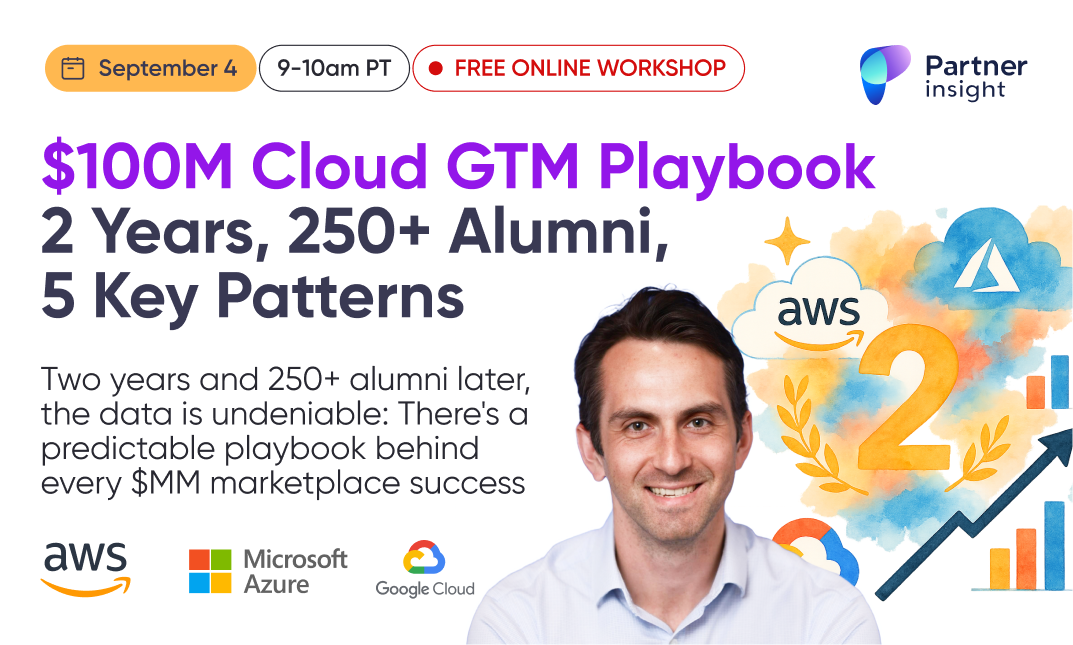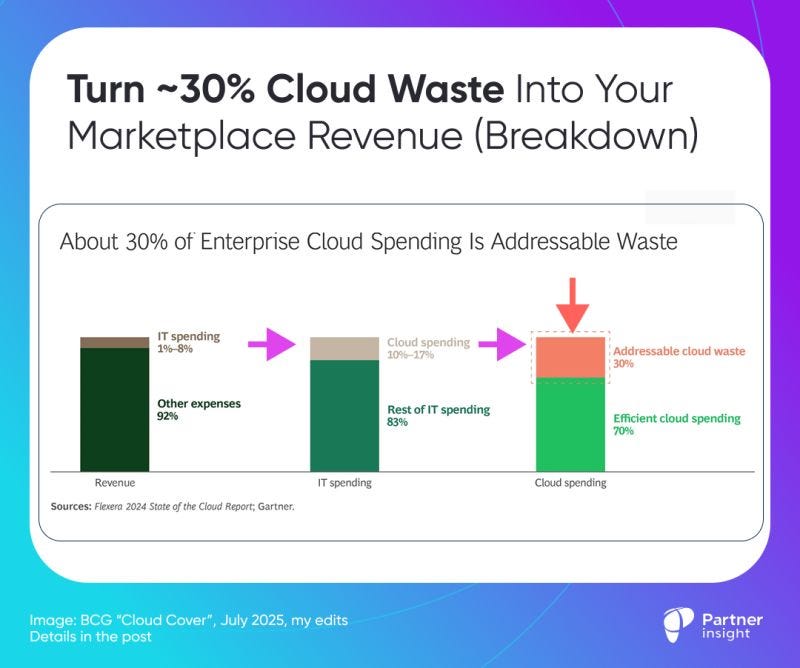Multi-Trillion Channel Shift: Jay McBain's 2030 Prediction
Hi, it's Roman Kirsanov from Partner Insight newsletter, where I deconstruct winning Cloud GTM strategies and the latest trends in cloud marketplaces.
This week we break down:
Jay McBain's bold prediction: the multi-trillion dollar channel ecosystem will "land at the marketplace" within 5 years—as AI opportunities (59% growth) converge with marketplace expansion (86% growth)
How ~30% of enterprise cloud spending sits as addressable waste, creating the biggest marketplace revenue opportunity for SaaS companies who know how to redirect it
Channel benchmark data revealing partner-sourced deals win 50% better than marketing-led motions, while driving 20-30% of revenue
These trends signal a fundamental shift where traditional partnerships and cloud marketplaces are converging into a single, dominant go-to-market engine.
Join our $100M Cloud GTM Playbook workshop on September 4th (next week!) where I'll share battle-tested patterns from 250+ marketplace transformations—including why some companies 10X their results while others plateau. This leads into Cohort 12 of our Cloud GTM Leader course starting September 9th.
Will the Multi-Trillion Dollar Channel Ecosystem "Land at the Marketplace" Within 5 Years?
This Jay McBain's prediction isn't just bold—it's backed by data showing convergence of the two fastest-growing trends in tech.
In this exclusive clip from his keynote at our Microsoft Marketplace event, Jay McBain, Chief Analyst at Canalys, explains how the $45B marketplace economy is rewiring partnerships, racing to $85B.
5 insights to shape your strategy:
AI Demands New Pricing Models— Only Marketplaces Can Handle Them
"Agentic AI is starting to look like micro consumption, a dollar or $2 per thing... The only way it's going to work is through marketplaces... because you're selling outcomes. You're not selling to a particular person," McBain explained.
Traditional sales processes can't handle dollar-per-outcome models for partners, but marketplaces can.
Convergence of Opportunities: 59% + 86% Growth
AI partner opportunities are growing at 59%, while marketplaces are growing at 86%—these are the "2 fastest growing parts of our industry," Jay explained. The convergence is creating unique partner leverage.
Partner Explosion is Real
"One company happens to grow 91% on a marketplace. They're growing their partners 3,548% in terms of distribution, in terms of these private offers, in terms of partners being included in the deals," McBain noted.
This isn't just marketplace expansion—it's channel transformation at unprecedented scale.
The math is compelling: "For every dollar of Microsoft there's $8.45 as a partner I can go chase. If I'm an ISV, it's over $10."
Partners Are Evolving Into Full-Stack Orchestrators
"So a partner isn't a partner anymore. It might be a VAR from the past, that's maybe how you have it categorized. But they're doing consulting. They look like a consultant. They look like a system integrator. They look like a managed service provider. And 44% of them are developing software."
This evolution means partners aren't just reselling—they're surrounding customers "at all stages before, during and after the transaction" and capturing 200-300% of deal value through services. For ISVs, this creates opportunities to orchestrate these new capabilities rather than compete with them.
In the "7 layer stack that agentic AI is going to be delivered," partners have a major role to play.
But it's an integrated role and "how it all plays is going to be as a team sport," Jay stresses.
Jay McBain's Marketplace Prediction
"So all of the channel partner, entire ecosystem that's been built around us for 40 years,
I believe, and my prediction is within 5 years actually lands at the marketplace, where the customer is going to be delivered in terms of their outcomes and their journey," Jay concludes.
What's your strategy to capture this AI-marketplace convergence?
Special Workshop: $100M Cloud GTM Playbook: 2 Years, 250+ Alumni, 5 Key Patterns
Two years and 250+ alumni since we launched the Cloud GTM Leader course, the data reveals something striking: Companies growing to $MM on marketplaces follow patterns most others never discover.
After analyzing hundreds of marketplace transformations, I'm hosting our anniversary workshop to share what we've learned about why some companies 10X their results while others plateau or never take off on marketplaces.
Here's what we'll cover September 4th:
The $100M Pattern Analysis - Data from 250+ transformations revealing the specific differences between companies that scale vs those that stagnate
The Strategic Commit Playbook - How top performers systematically access $469Bn in enterprise cloud commitments instead of waiting for random deals to appear
Case Study Deep-Dive - Live breakdown of companies that scaled on marketplaces to $MM+ using these exact frameworks, with specific tactics you can implement immediately
The Internal Champion Blueprint - Why most marketplace initiatives fail internally, and the proven methodology to turn your sales and other teams into advocates
Latest Marketplace Intel - Exclusive trends and opportunities most alliance leaders won't discover until it's too late
This isn't theory. These are battle-tested frameworks from our Cloud GTM Leader community, that include alliance leaders at companies like Citrix, Wiz, and Darktrace who've cracked the marketplace code.
📅 Join me at $100M Cloud GTM Playbook Workshop: September 4th at 9-10am PT
This workshop leads into Cohort 12 of our Cloud GTM Leader course starting September 9th - our 2-year anniversary cohort.
The companies that leverage these patterns will capture higher marketplace share and outpace competitors.
Turn ~30% Cloud Waste Into Your Marketplace Revenue (Breakdown)
Up to 30% of enterprise cloud spending is underused or "wasted."
Here's the math behind it and why this could be the biggest cloud marketplace opportunity for SaaS and alliance leaders.
Cloud costs now represent up to 17% of total IT budgets, while IT spending typically accounts for 1-8% of company revenue (BCG, 2025). Median spend is 5% of ARR for hosting alone in private B2B SaaS (SaaS Capital).
This means cloud spend can reach 1-1.5% of total enterprise revenue. That's not pocket change—for a $100M ARR company, we're talking $1-2M spending annually on cloud.
As companies migrate more workloads and adopt AI, cloud claims growing budget share.
Organizations exceeded their public cloud budgets by 17% last year while planning 28% YoY growth of spend this year—3.5X faster than overall IT spend growth of 7.9% (Flexera, Gartner).
Addressable waste is real and massive
Boston Consulting Group (BCG)'s latest analysis reveals that ~30% of this cloud spend is addressable waste from overprovisioning, poor resource utilization, ineffective discount strategies, data storage inefficiencies, and lack of FinOps practices.
Companies are improving—Flexera puts cloud waste at 27% in 2025 (down from 34% a few years ago).
But given that customers now pay $248B annually to AWS, Azure, and GCP, the scale remains massive (my breakdown of annual run rates).
This is where cloud marketplaces become your strategic lever
96% of organizations already use cloud provider discounts, with significant portions locked into formal contracts (Flexera):
Microsoft Azure: 45% use Azure Enterprise Agreement discounts
Google Cloud: 44% use Google Committed Use discounts
AWS: 40% use AWS Enterprise Discount Program (EDP)
These pre-committed budgets—now totaling $469B across hyperscalers (my analysis- link in comments)—create a natural funnel to marketplaces, where customers can apply existing cloud spend toward third-party software purchases.
The math is compelling. If even half of that 27% waste redirects to productive marketplace purchases, we're talking billions in accessible budget that doesn't require new approvals or procurement cycles.
This also creates win-win-win for SaaS alliance leaders, hyperscalers and cloud customers.
What this means for alliance leaders:
Efficiency positioning:
Position buying your SaaS on marketplace as helping customers maximize ROI on existing cloud commitments
Budget accessibility:
Tap into revenue already committed/signed to cloud spend. Plus it’s a broader cloud optimization for them too.
Growth leverage:
Ride the 28% annual growth wave by embedding your solutions in customer cloud procurement workflows
What's your strategy for turning cloud commits into your marketplace wins?
Join 250+ alliance leaders who’ve mastered cloud marketplaces of Azure, AWS and Google Cloud with our Cloud GTM Leader course. Our alumni are closing $MMs in marketplace deals and scaling fast. Cohort 12 starting on September 9th!
Channel Benchmarks 2025: 20–30% of revenue, higher Win-Rate
Channel-sourced deals win 50% better than marketing-sourced. In a market where sales cycles stretched 3-4 weeks and opportunity cost doubled in early stages, partners drive 20% of revenue —playing a critical role in scaling.
ICONIQ's State of GTM 2025 data (from GTM executives of 200+ B2B SaaS companies) shows channel partners as the key growth engine for companies that scale.
Note: ICONIQ uses “channel / partnerships” broadly, usually including SIs, resellers, cloud marketplaces, etc.
My key highlights:
Channel-sourced deals convert significantly better (~25–35% ) vs Marketing-led motions (18–22%)
Direct sales still wins at ~35–40% conversion, but the gap between Sales and Channel is far narrower in the mature stages, when companies truly lean into partnerships.
By $250M+ ARR, channel close rates approach direct-sales close rates (Channel ~35% vs. Sales ~41%).
Mature orgs usually operationalize partner motions—enablement, rules of engagement, shared pipeline, and seller incentives aligned to co-sell.
Channels contribute ~20% of revenue on average, rising to ~30% for $250M+ ARR companies
High-growth companies lean harder on partners: 25-30% channel share in recent years vs ~20% for slower-growth peers.
Below $25M ARR, channel share is lower at 16%—partnerships take time to build.
Above $25M ARR, 4 out of 5 companies generate ≥10% via channel (share rising with scale).
Infrastructure vendors rely even more on partners—30%+ channel share across stages. If you’re infra-adjacent, raise your channel ambition.
Software market is much tougher now
Sales cycles are longer
Average sales cycles stretched by +3–4 weeks YoY; (in fintech they jumped 12 weeks in the last 2 years)
Cost per opportunity is up significantly
It nearly doubled to 10K for <$25M ARR and increased across other categories, except for >250M (where channel is 29% of revenue, possibly giving operating leverage).
But consistent YoY reliance on channels is a key GTM lever, even amid AI disruptions
Despite shifts in AI-native vs. non-AI GTM strategies, channels remain stable at ~20% revenue contribution, signaling to alliance leaders that partnerships are resilient and essential.
3 Insights for alliance leaders
Start building channel/partnerships early (ideally before $25M ARR) for long-term scalability. If you wait to “get serious” at $100M+, you’ll pay a maturity tax later.
Treat channel as a core engine, not a side bet. It drives reliable conversions in complex buys and uncertain markets.
Benchmark your channel programs and accelerate partner enablement to capture this proven revenue stream.
Opportunity costs rose sharply for businesses below $250M, while those with mature channels maintained efficiency. As direct sales gets pricier, channels could be your oxygen.
Source: research
P.S. Made it to the end? Appreciate you!
If you found these insights valuable, please subscribe or share this newsletter with your network—it's free and helps us reach more alliance leaders navigating these transformative trends.





